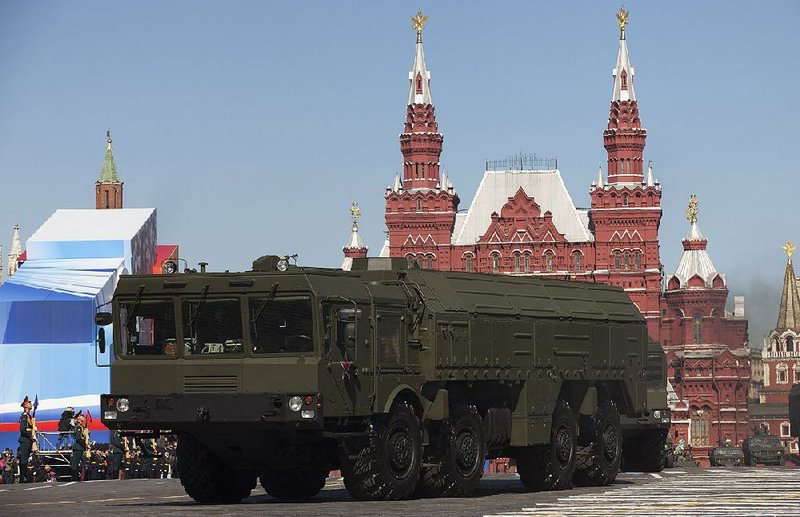MOSCOW -- Russia plans to station state-of-the art missiles in its westernmost Baltic exclave and deploy nuclear-capable bombers to Crimea as part of war games to showcase its resurgent military power as tensions continue with the West over Ukraine.
The Russian military exercises this week range from the Arctic to the Pacific Ocean and involve tens of thousands of troops, the Defense Ministry said Tuesday.
The Iskander missiles will be sent to the Kaliningrad region that borders NATO members Poland and Lithuania as part of the maneuvers, said a Defense Ministry official, who spoke on condition of anonymity because he wasn't authorized to comment publicly.
The official also said Russia will deploy long-range, nuclear-capable Tu-22M3 bombers to Crimea, the Black Sea peninsula that Russia annexed from Ukraine a year ago.
In a statement, the Defense Ministry said the Baltic Fleet, the Southern Military District and the Airborne Forces have been taken to the highest stage of combat readiness and have started moving to shooting ranges as part of the drills.
The wide-ranging exercise started Monday, when President Vladimir Putin ordered the Northern Fleet and other military forces on combat alert as part of the exercise in the Arctic. Other units in the Pacific region, southern Siberia and southwestern Russia also started drills.
The Iskander missiles, which are capable of hitting enemy targets up to 310 miles away with high precision, can be equipped with a nuclear or a conventional warhead. From Kaliningrad, they could reach several NATO member states.
NATO has taken moves to deploy forces closer to Russia's borders in response to the country's role in the crisis in Ukraine.
Polish Prime Minister Ewa Kopacz interpreted the war games as an attempt by Russia to pressure European Union nations as they consider possible new sanctions against Russia over Ukraine.
"Russia is making this gesture before the European Council meeting," she said. "It is trying to influence European Council decisions concerning extending or adding new sanctions."
Foreign Minister Edgars Rinkevics of Latvia, which holds the EU presidency, said Tuesday that he did not expect "a discussion of new sanctions or any decisions" when EU leaders meet Thursday in Brussels.
Igor Sutyagin, a Russia expert at the Royal United Services Institute, said beefing up forces in the Baltic exclave was a top priority for the Russian military.
Iskander missiles already had been sent briefly to Kaliningrad during December's military maneuvers but were pulled back afterward.
U.S. Air Force Gen. Philip Breedlove, NATO's supreme commander in Europe, has termed Russia's "threats to deploy nuclear-capable Iskander-M missiles in Kaliningrad" as part of what he called the Kremlin's "pattern of continuing behavior to coerce its neighbors in Central and Eastern Europe."
The Kremlin, in its turn, has voiced concern about U.S. plans to beef up its military presence near Russia's borders. Later this month, U.S. troops are holding joint exercises with forces from EU nations Estonia, Latvia and Lithuania.
Four Polish NATO MiG-29s flew training missions in Lithuania on Monday under the command and control of an alliance Airborne Warning and Control System surveillance aircraft in a small corridor between Belarus and the Kaliningrad region. The mission -- described as "routine" by NATO officials -- prompted the Russian military in Kaliningrad to scramble a half a dozen fighter jets to monitor the exercise.
Monday's Airborne Warning and Control System mission was flying from Oerland airbase, near Trondheim in Norway. The flights were part of efforts to reassure NATO members in eastern Europe, in particular the Baltic states, which are concerned about Russia's intentions amid the Ukrainian crisis.
Polish Defense Minister Tomasz Siemoniak said Tuesday that a battery of U.S. anti-aircraft Patriot missiles will be coming to Poland later this month for a major exercise. He previously said 10,000 foreign troops will be taking part in NATO exercises in Poland this year, the highest number ever.
Information for this article was contributed by Monika Scislowska, John-Thor Dahlburg and David Keyton of The Associated Press.
A Section on 03/18/2015
